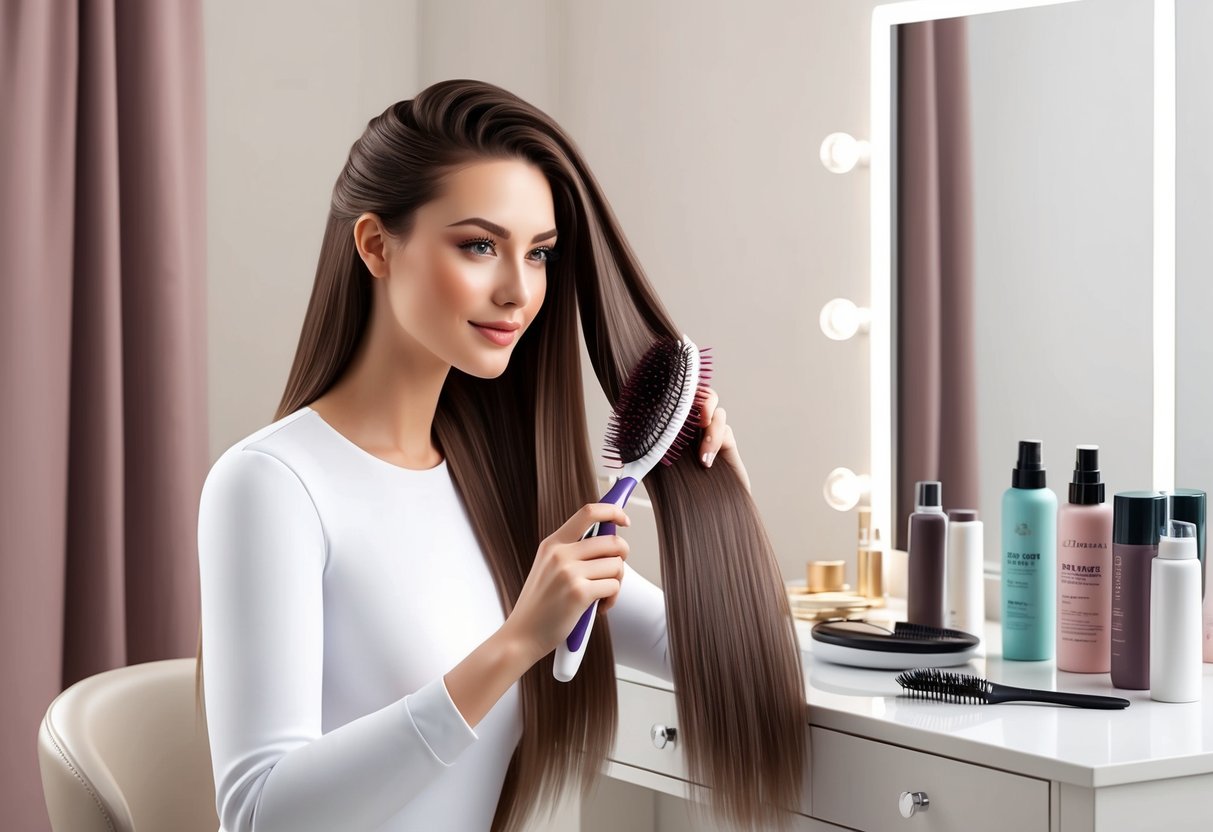
Boosting Hair Growth Naturally
Healthy hair growth depends on a combination of daily care methods and making smart nutritional choices. Targeting the health of the scalp and ensuring a diet rich in the right vitamins and minerals are proven methods to support stronger, longer hair.
Encouraging Growth With Scalp Care
Consistent scalp care is essential for creating the best environment for new hair growth. Massaging the scalp for a few minutes each day increases blood flow, which delivers oxygen and nutrients to the hair follicles.
This simple step can stimulate growth and help maintain a healthy scalp. A gentle scalp massage works well with or without oil.
People with oily scalps can perform dry massages, while those with dry skin can benefit from nourishing oils such as coconut or argan. Using the fingertips in circular motions is recommended.
For those looking to address specific concerns, targeted scalp treatments can be beneficial. As discussed in hair growth guides, maintaining scalp health is a priority for long, healthy hair.
It is also important to avoid harsh styling products, excessive heat, or having buildup that can clog hair follicles. Cleanliness and regular exfoliation with gentle scrubs can prevent issues that obstruct hair growth.
Benefits of Biotin and Nutrition
Proper nutrition is critical for promoting long, healthy hair. Protein is a key building block of hair structure, so diets low in protein can weaken hair and slow growth.
Iron is also vital since deficiencies can lead to thinning. B vitamins—especially biotin—support keratin production and play a significant role in follicle health.
Biotin, in particular, is often recommended for those seeking natural ways to encourage hair growth. Foods like eggs, nuts, seeds, and leafy greens supply biotin and enhance overall hair quality.
Supplementation might help those with deficiencies but is not necessary for everyone. For more on nutritional essentials, refer to guides that emphasize biotin and nutrition for hair growth.
A balanced diet with vitamins A, C, D, E, zinc, and healthy fats supports the scalp’s natural oils and gives hair strands the nutrients they need to grow longer and stay strong. Reducing sugar and processed foods may help minimize breakage and shedding, allowing for more noticeable results over time.
Styling Tips for Long Hair

Long hair requires special attention to keep it strong and healthy. Key strategies like gentle handling, creative styling, and daily best practices minimize breakage and help achieve gorgeous, manageable locks.
Gentle Styles to Prevent Breakage
Healthy long hair can be easily damaged by harsh styling habits. Opt for loose ponytails, soft braids, or low buns instead of tight elastics that pull on the scalp and strands.
Use fabric-covered hair ties or spiral bands, as these create less friction and reduce split ends. It is helpful to alternate between styles to avoid stressing the same spots.
Never style wet hair tightly; damp strands are more vulnerable to snapping. Detangling with a wide-tooth comb or fingers before styling can minimize frizz and prevent accidental breakage.
Securing hair with silk or satin scrunchies lowers the risk of tangles overnight. For added protection, wrap hair loosely in a scarf or use a silk pillowcase.
Creative Updos and Braids
Long hair offers endless opportunities for creative styling. Classic braids, like the French or Dutch braid, evenly distribute weight and protect the hair shaft.
Low and twisted buns, crown braids, or fishtail plaits are not only visually appealing but help keep hair out of the way. Accessories like hair sticks, gentle clips, or decorative pins add interest without damaging strands.
Try combining multiple small braids or buns for variety—these styles are low-tension and suitable for long, healthy hair. For step-by-step inspiration, check Byrdie’s hairstyle ideas for a mix of updos and braids that don’t require advanced skill.
Rotating styles reduces repetitive stress and helps maintain hair strength.
Everyday Styling Dos and Don’ts
Daily habits impact the long-term health of long hair. Always start with clean, detangled hair and apply a lightweight leave-in conditioner or serum before heat styling.
Limit the use of hot tools; if needed, set them on the lowest effective heat setting. Allowing hair to mostly air dry before finishing with a blow dryer can reduce heat exposure.
Avoid backcombing, aggressive brushing, and overuse of styling products that may cause buildup. Regular trims prevent split ends from traveling up the hair shaft.
Choosing the right styling tools is crucial—soft-bristle brushes and seamless combs are gentle on long, healthy hair. More detailed styling routines and product suggestions are found in HerStyler’s tips for long hair.



